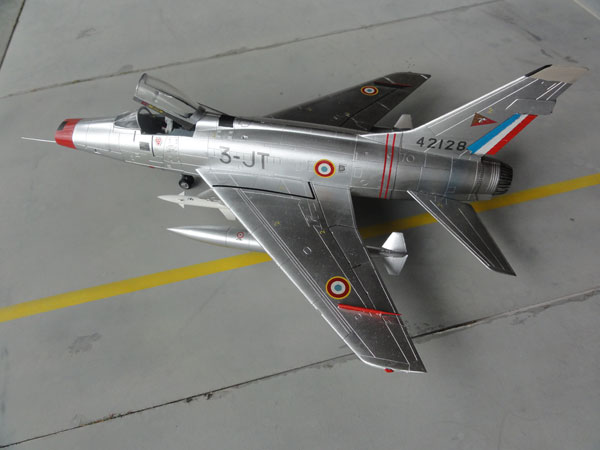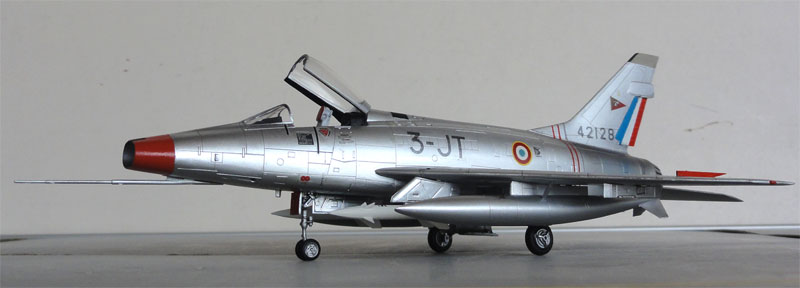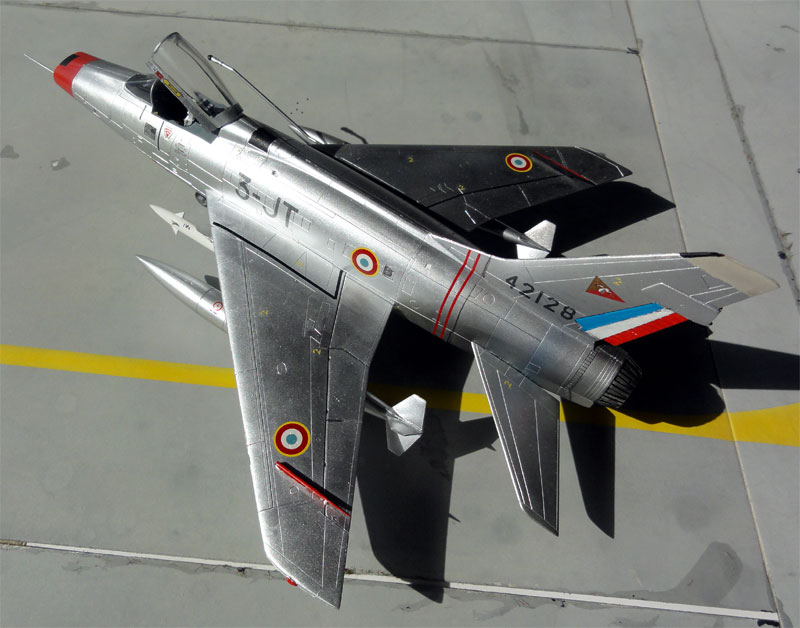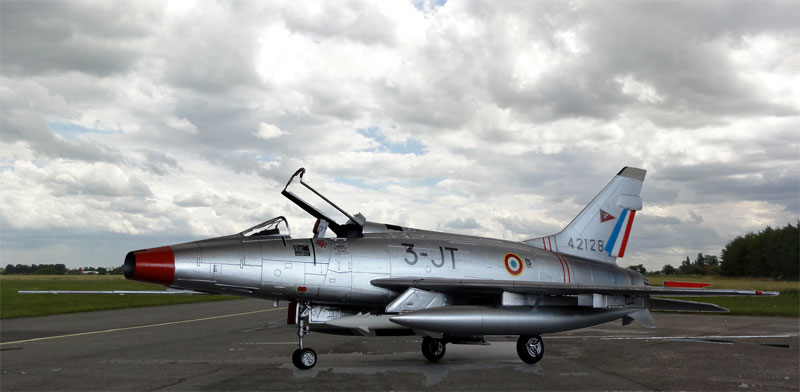"Super Sabres"
1/72 scale kits of the North American F-100D Super Sabre made by Meindert de Vreeze

page 1
page 2
page 3
page 4

The aerodynamic research for high speed aircraft after the Second World War explored various concepts like swept wings and delta wings (like the Convair XF-92). Design of the F-100 with a swept wing started in 1951 and the first prototype flew in May 1953. Some improvements had to be made and the first F-100A entered USAF service September 1954 as fighters with some 200 build. Many problems were experienced, but still development continued.
The next variant was the F-100C entering USAF service in July 1955. It had an improved J57-P-21 engine and it could carry fuel tanks as well. About 475 were build.
The F-100D was a significantly changed and much better version. It got a larger wing area (with extended trailing edge "Yehudi") and larger vertical tail. A new canopy type, different cockpit and ejection seat are other changes. The F-100D became available at the end of 1956 for the USAF and over 1,200 were build.
All F-100 versions experienced problems in flight, electronics, structure and many accidents happened. So a two seater trainer, the F-100F, was also developed, entering USAF service in 1958. No less than 350 were manufactured as it was really understood that flying a supersonic fighter would require better training.
USAF Super Sabres were also deployed to the European content, starting with the Berlin crisis in the nineteen fifties. Super Sabres were also used by Taiwan, Danmark, Turkey and France. The French Armee de l 'Air was the first Western-aligned air force to receive the type, arriving May 1958. A total of 100 aircraft (85 F-100Ds and 15 F-100Fs) were supplied to France, and assigned to the NATO 4th Allied Tactical Air Force. The French Super Sabres were delivered under a US military assistance program, before De Gaulle took a more isolated NATO course. French F-100's were used until late 1970's.
The USAF also
used the "Hun" during the Vietnam War in attack and even in Wild Weasel
roles. By 1972, many USAF F-100 aircraft were allocated to the US Air National
Guard (ANG). In 1979 they were all super ceeded by the far better F-4 Phantom
and later the F-16.
I also made large 1/32 scale F-100D Super Sabre model before the Trumpeter kit based on the vacuform ID MODELS F-100. LOOK HERE....
F-100 models
I took a look at my model stash and saw a whole pile of F-100 Super Sabre kits in 1/72 scale. A very old kit I bought in 1983, so more than 29 years ago, was the old Hasegawa F-100D kit. It had a USAF Vietnam and metallic schemes and decals included and I bought it in a local toy store, BIMBO in Apeldoorn, The Netherlands for a mere Dutch guilder 9,85 FL. I had already started modelling it more than 20 years ago and it was even filled with putty and sanded when found in the box. It had been hiding for so many years, but now it was time to finish it.
Alongside the Hasegawa kit a much better 1/72 ESCI F-100D kit was found as well as an AMT kit of the F-100F two seater. The AMT kit has many parts in common with the ESCI kit. So what kept me to start this little 1/72 F-100 project?
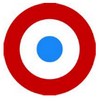
I found also a very nice Modeldecal sheet no. 69 with French Super Sabres, dating back from 1983. These sheets were rare at that time in the Netherlands and I bought it for some 8 guilders at the time. It had a choice of several metal schemes but also a camouflaged Thud and these decals, as always were well researched. The Modeldecal set has decals for natural metal schemes of:
-1- F-100D of EC 2/3 Champagne , based at Reims and Lahr (West Germany), circa 1962
-2- F-100D of EC 1/2 Navarre
-3- F-100D of EC 3/11 Corse around 1971
-4- F-100D of EC 1/11 Roussillon circa 1960; camouflaged Federal Standard FS 34079, 34102, 30219 and 36622 light grey-white colours:
-5- F-100F two seater of EC 2/11 Vosges around 1975
-6- F-100D EC 4/11 Jura based at Djibouti Africa around 1978 (with shark teeth).
So as I had completed some French Cold War jets, I opted to make the ESCI kit into a French F-100D of the Armee de l 'Air. (see below for more details...)
The AMT kit decals for the F-100F
looked great with very colourful USAF F-100F's.
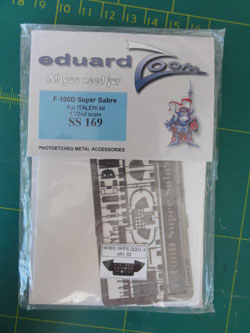
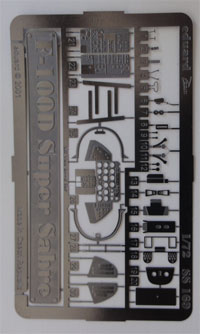
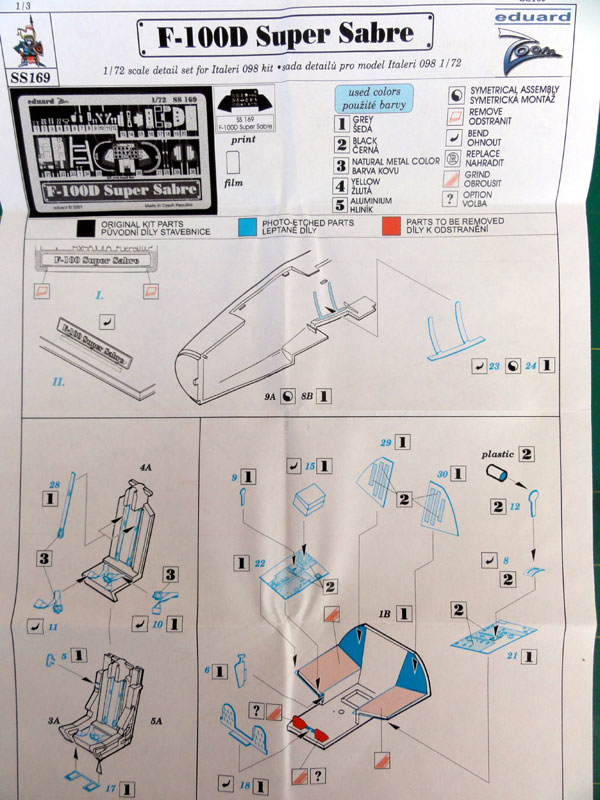
So, let us start with the models: (1) First the ESCI kit.
ESCI

The ESCI kit F-100D (no 9022) from 1982 was a great improvement over earlier kits in 1/72 scale. This kit has about 75 parts in tan coloured plastic and looks fine with some recessed panel lines.
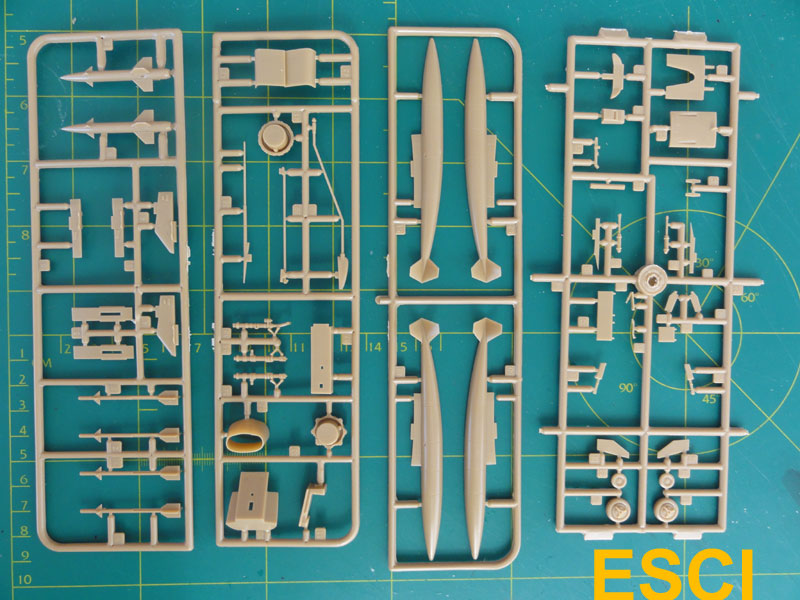
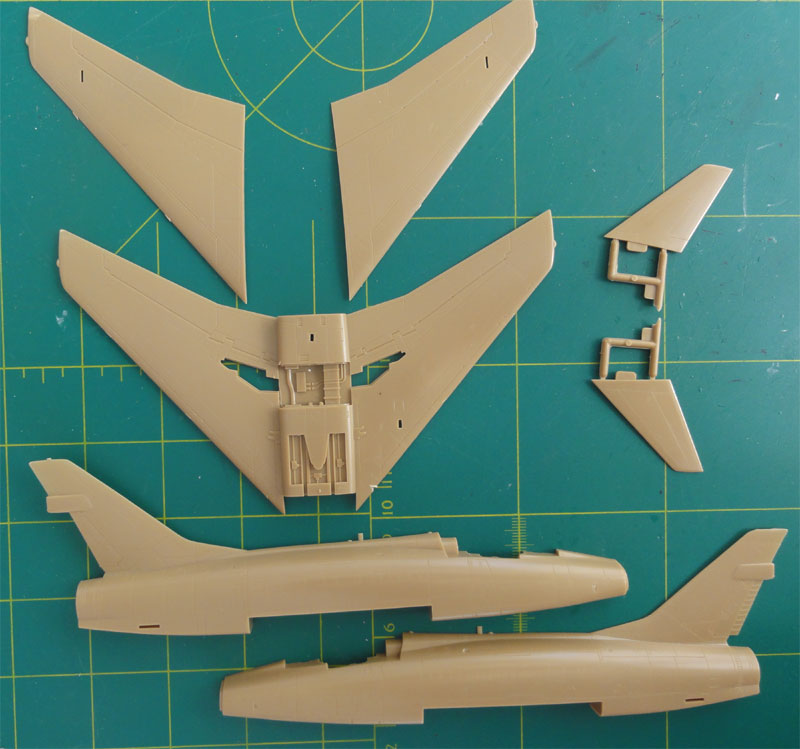
The kit has horizontally split fuselage with single wing assembly and a vertical split.
For the stores it has many pylons for under the wings, "stores" are Bullpup and Sidewinder missiles and the later style and longer 335 gallon fuel tanks. The Sidewinder horizontal "T-" pylons look a bit strange. The nose intake is very undeep with no intake tunnel.
The kit has the ventral speed brake with the later style larger cut-out for a central fuel tank (this is not in the kit). Two types of engine nozzles are supplied as well as the later standard arrestor hook. The wing slats are integrally moulded "closed" with the wing. On the transparant single clear canopy a strange rear frame is moulded at the rear, it should NOT be there so polish this away.
It appears that the arrester hook was fitted after 1962 on most USAF aircraft so was not present on earlier Super Sabres.
No bombs, TERs or rockets are in the
kit; this I will get from a Fujimi A-4 Skyhawk kit, or get these from a
Hasegawa Stores Set.
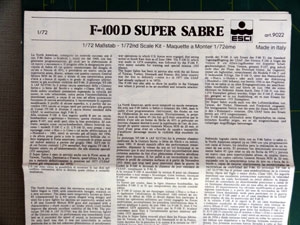 ..
..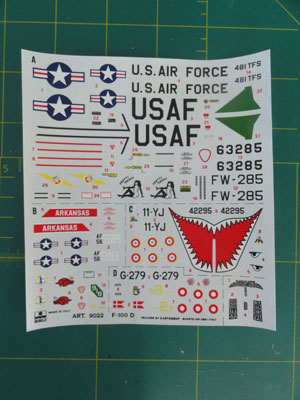
The ESCI kit itself has decals for:
(a) French AF Super Sabre of EC 4/11 Jura as well with shark teeth (as in the Modeldecal set 69).
(b) USAF 481 TFS named "Petty Penny"
(c) Danmark air force, Escadrille 730 in overall green
(d) USAF 184 TFS, Arkansas ANG with "Vietnam style" camouflage with red tail band.
![]()
This 1/72 ESCI model with some minor work it can be a
bit improved.
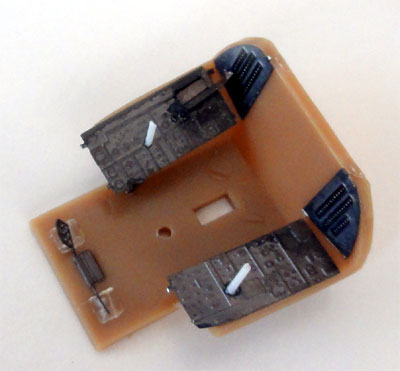
The cockpit would get some more detail.
I used some of the EDUARD etched metal parts like the side consoles.
The characteristic big nose intake is quite undeep. So the closed noses of the fuselage halves were cut open, the nose intake ring is separate. But this also led to create a intake air flow tunnel, so this was made using plastic card. The edges and gaps inside the intake well simply filled with white glue that dried out perfectly.
The cockpit edges were a bit altered
to look more as the real edges, areas cut out with a modelling knife as
well. The inside of the cockpit was painted as per Modeldecal suggestions
mat grey like the ejection seat.
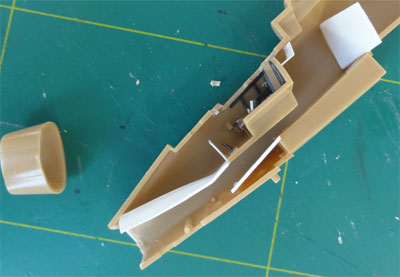 ..
..
Most parked F-100 Super Sabres have their slats and horizontal stabilizers drop down a bit (but not always!). For this model, I kept the slats retracted as in the kit, (but for the later to be made AMT kit of the F-100F the slats will be cut loose from the wing parts).
The fixed position lip of the stabilizers parts 45 + 46 were cut off however and the gaps in the rear fuselage section filled and sanded. (The stabilizers themselves will be set on at an angle later on).
The rear exhaust part 33 or 41 is also very undeep. So it was
drilled open to make it look deeper using a bit of tubing. The clip
for the drag chute cable under the fuselage should only be on the left
side, so fill and sand.
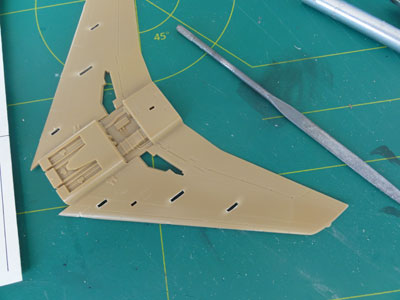 ..
..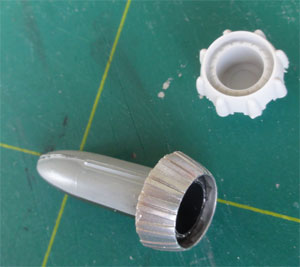
The wing pylon location openings
were opened up as well.
The ESCI kit otherwise needed almost
no filler so that was great.
After assembly, the overall kit got a base coat of grey applied
with the airbrush as well as the smaller parts like undercarriage doors
and stabilizers. For smaller models I often first put on the basic paint
schemes followed by the decals for much easier handling and avoiding breaking
parts.

For the French F-100D, the Modeldecal
scheme (see above) for the esquadron "EC 2/3
Champagne", serial 54-2128 with code 3-JT was chosen. This unit was based
during the Cold War at Lahr NATO airbase in West Germany. It has a metallic
overall look. ( Later on in their careers, French Super Sabres were painted
dull silver for anti-corrosion purposes, but during this period Super Sabres
were still metallic looking).
This French aircraft has a red nose,
so this was first airbrushed to prevent masking of the vulnerable metal
coat later on. Next, this model was to get the ALCLAD II metal treatment.
It was well polished to remove any scratches. I did not want a very blinking
model in this 1/72 scale, I feel it is a bit overdone. So I did not apply
a gloss black undercoat, but simply a first coat of silver using Revell acrylic Aqua #90 paint with my fine Harder
Steinbeck airbrush.
Next, came a coat of Johnson Clear/Pledge gloss varnish to get a smooth gloss undercoat for the ALCLAD. Next coats were thin mists applied with the airbrush of ALCLAD II Polished Aluminium ALC-105. (Note: ALCLAD can NOT be brush painted).
All the not yet fitted parts like
undercarriage, doors, pitots and booms were not forgotten to get their
coat as well. The opening canopy frame was already also sprayed in the
metallic colour as well.
On real Super Sabres the rear fuselage
has often a burned hot metal look. On the model, the rear fuselage got
some some areas of ALCLAD II Steel
and some strains of transparent Tamiya blue
and yellow to show the burnished metallics
seen of real Super Sabres.

The Modeldecal set has no French
roundel decals and no decals for the French flag on the rudder. So the
rudder was painted white first and then followed with a red trailing edge.
The blue came from a spare decal from my decalbox. It is noted that finding
the correct blue hue is quite difficult so always keep any French decals
you have from other kits in your decal spares box.
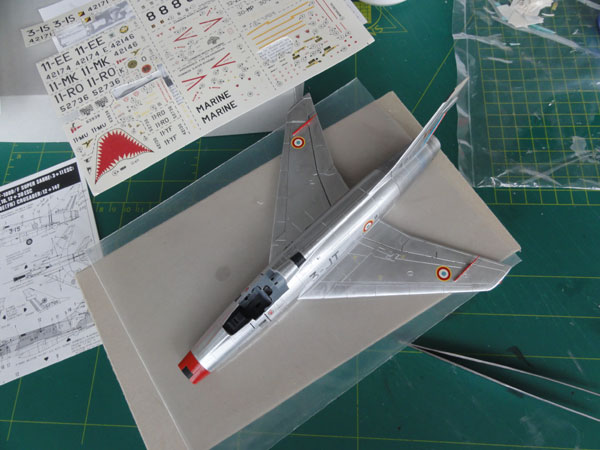
The French roundels which are a bit
larger than those in the ESCI kit on metallic schemes and came from MODELDECAL
sheet 62.

I always "drag each decal" through an amount of Johnson Future/Pledge. This minimizes "silvering" and helps adhering to the model surface. The smooth ALCLAD paint certainly helps here as well.
The model really looks nice now. Next, the smaller parts were added like undercarriage, wing fuel tanks and probes.
I wanted to set the canopy open.
The canopy glass part #20c is one
piece. It also has a strange frame moulded at the rear, it should NOT be
there. So this was polished away with a nail polishing block and Tamiya
rubbing compound (or use any other stuff you have for polishing).

NOTE: inside the canopy the round bulge moves along with the canopy as it is installed inside. The kit bulge is moulded fixed onto the fuselage halves (indicated to be painted "A" back by ESCI in kit instructions STEP 2). So you need than to cut away the bulge at each halve. Make a new bulge for inside the canopy rear. I found out too late so did not do this on this model.
The separated windscreen frames were hand painted,
any spilt over paint can be removed from the transparent windscreen with
a tooth pick easily once dry. The windscreen was than set on the model,
fit is good with some gaps closed with white glue. Smaller gaps closed with white glue. When dry, these were
painted metallic with a fine brush.
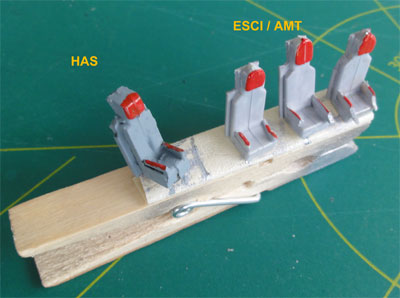 ..
..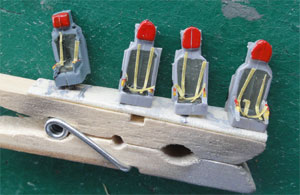
The ejection seat is a bit rough
with one single plastic part. It removed the edges on the headrest and
added arm rests. The headrest is red with harnesses and seat straps in
various colours. The parapack and cushions were painted medium green.
Some black details were painted with a fine brush on grills and vents with very thinned black paint, as well as in the flying surfaces gaps at the flaps and slats. The wingtip lights were painted with drops of red and blue paint and a drop of MicroScale Kristal Kleer.
After drying for 24 hours, finally the model got a decal protecting coat of Johnson Future/Pledge with the airbrush.
The characteristic later style long 335 gallon fuel tanks were set on the model, they are accurate. Also a couple of inboard pylons for the BullPup missiles. Those in the kit were used and simply painted white with some coloured bands. Nice outboard pylons are provided as well as a refuelling tank boom and pitot nose probe.
Some views of the completed model...
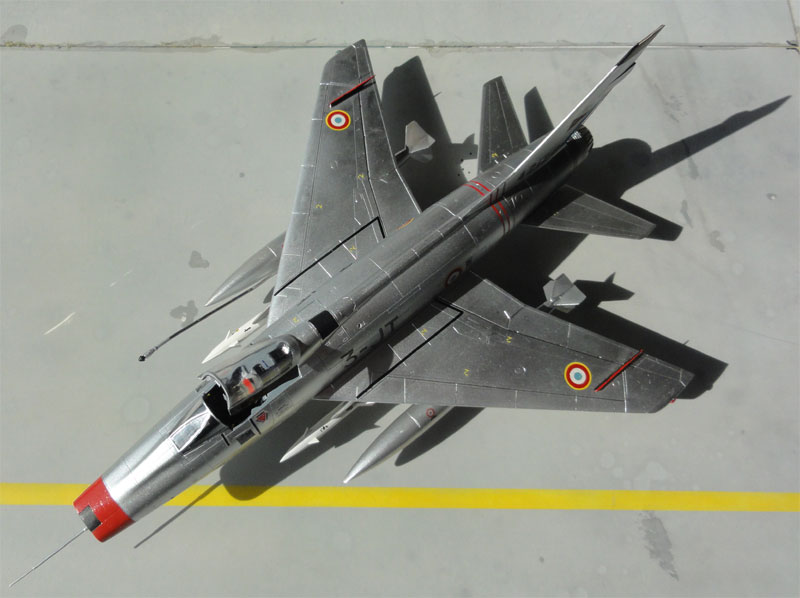
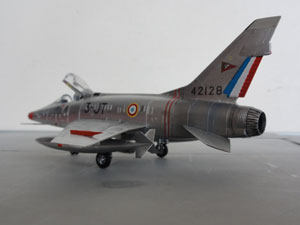 ..
..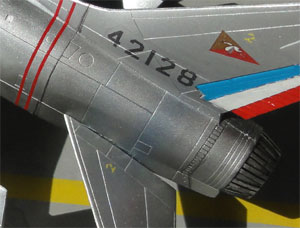
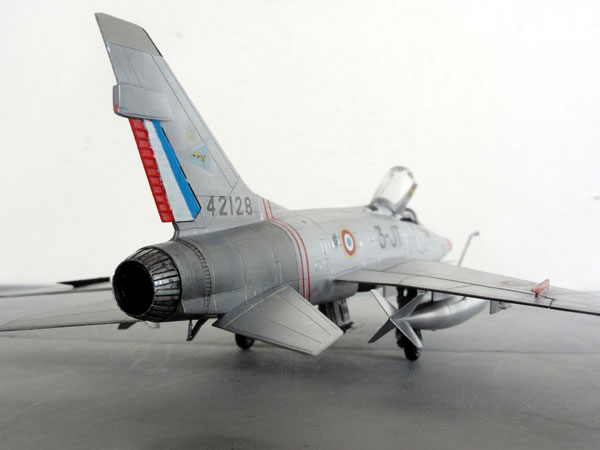
here the Bullpup missiles are seen
on the inboard pylon..

...and in a landscape... and above
the Mediterranean...
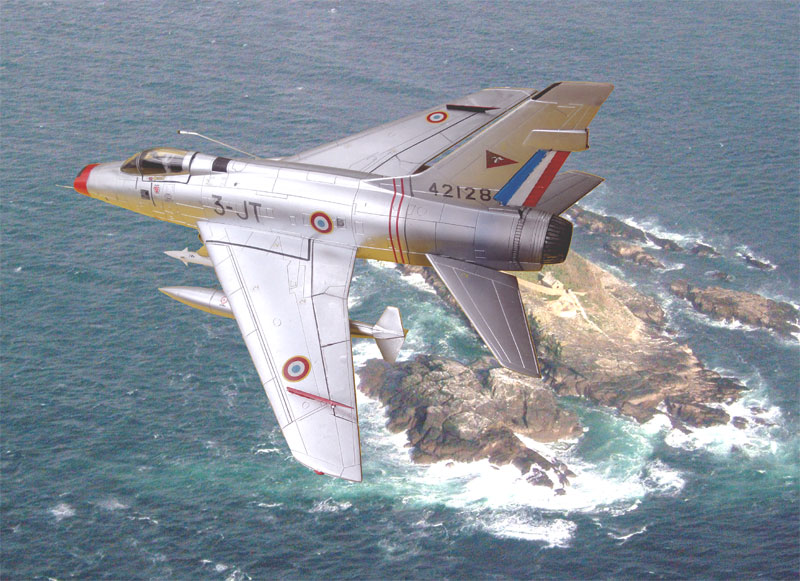
A nice addition to my French Cold War Jet Model collection like the Dassault jets of the Mystere and Super Mystere.
Next will be the AMT 1/72 scale kit for a two seater F-100F, with many parts in common......
On to next
[ Page 2... ]

Back to 1/72 Models.......
References:
- F-100 Detail & Scale, Volume 33, Bert Kinzey
- F-100 in action, no. 48 or 1190 , Squadron Signal
- North American F-100 Super Sabre, Profile Publications no. 30 (British nostalgia!)
- The Century Series: The USAF Quest for Air Supremacy,1950-1960, Schiffer publications
Internet:
http://www.f-100.org/
https://supersabresociety.com/f-100-information/
IPMS The Netherlands F-100
Walk Around

(c) Copyright "designer"/ All rights reserved. Your comments are welcomed by webmaster
Created this page
June 24, 2012
